现在进行时详解
- 格式:doc
- 大小:41.00 KB
- 文档页数:4
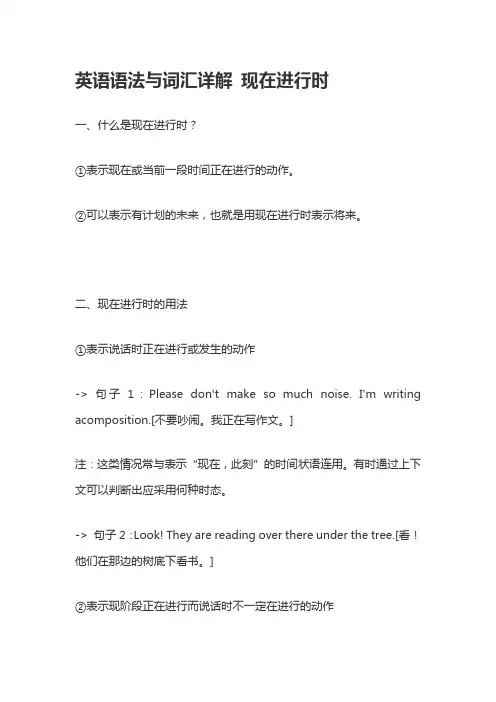
英语语法与词汇详解现在进行时一、什么是现在进行时?①表示现在或当前一段时间正在进行的动作。
②可以表示有计划的未来,也就是用现在进行时表示将来。
二、现在进行时的用法①表示说话时正在进行或发生的动作-> 句子1:Please don't make so much noise. I'm writing acomposition.[不要吵闹。
我正在写作文。
]注:这类情况常与表示“现在,此刻”的时间状语连用。
有时通过上下文可以判断出应采用何种时态。
-> 句子2:Look! They are reading over there under the tree.[看!他们在那边的树底下看书。
]②表示现阶段正在进行而说话时不一定在进行的动作-> 句子1:We are working in a factory these days.[这几天我们在一家工厂工作。
]-> 句子2:They are compiling a dictionary.[他们在编一本词典。
这类情况常与表示“时间段”的时间状语连用。
]注:这类情况常与表示“时间段”的时间状语连用。
③在口语中表示主语计划将要做的动作-> 句子1:Is your brother departing soon?[你的兄弟很快就要起程吗?]注:这类情况常与come来,go去,leave离开,depart离开,arrive 到达,stay逗留,start开始等动词连用。
所用的动词必须是动作而不是状态,主语必须是人。
④现在进行时与always等副词连用时带有感情色彩-> 句子1:He's always quarrelling with others.[他总喜欢跟别人吵架。
]-> 句子2:She is constantly worrying about her son's health.[她不停地为她儿子的健康担心着。
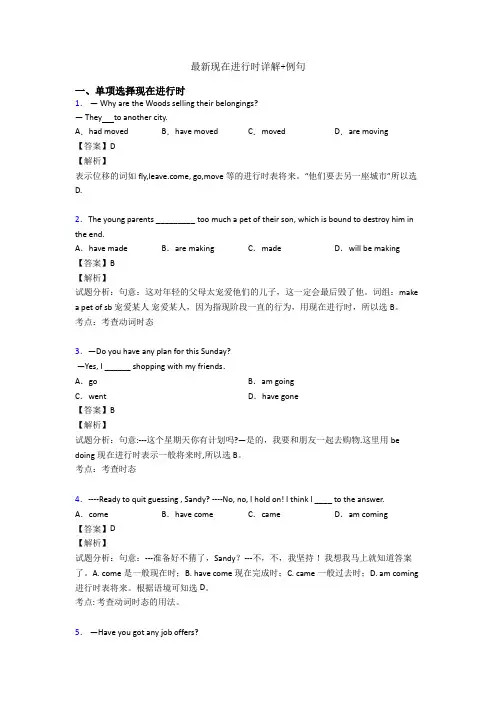
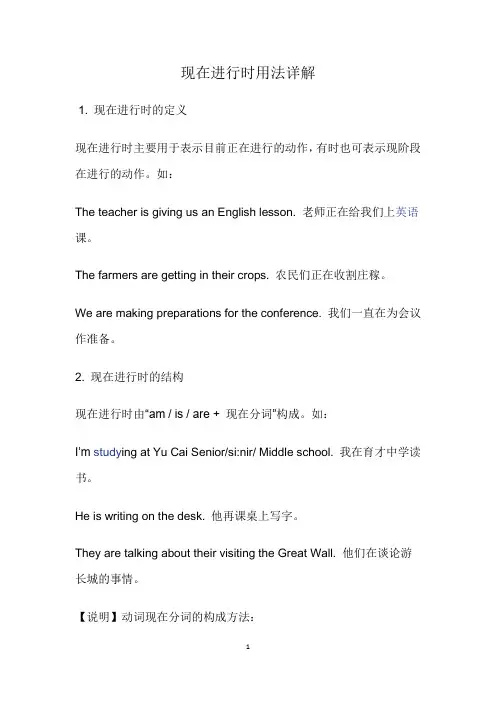
现在进行时用法详解1. 现在进行时的定义现在进行时主要用于表示目前正在进行的动作,有时也可表示现阶段在进行的动作。
如:The teacher is giving us an English lesson. 老师正在给我们上英语课。
The farmers are getting in their crops. 农民们正在收割庄稼。
We are making preparations for the conference. 我们一直在为会议作准备。
2. 现在进行时的结构现在进行时由“am / is / are + 现在分词”构成。
如:I’m study ing at Yu Cai Senior/si:nir/ Middle school. 我在育才中学读书。
He is writing on the desk. 他再课桌上写字。
They are talking about their visiting the Great Wall. 他们在谈论游长城的事情。
【说明】动词现在分词的构成方法:(1) 一般在动词后加-ing。
如:say—saying, play—playing, think—thinking, study—study ing, teach —teaching, blow—blowing, build—building.(2) 动词若以-e结尾, 则去e再加-ing。
如:love—loving, make—making, guide—guiding, date—dating.(3) 在以单短元音的重读闭音节结尾,且末尾只有一个辅音字母的动词后,双写最后一个辅音字母,再加-ing。
如:begin—beginning, regret—regretting, plan—planning, ban — banning.(4) 在以ie结尾的动词后,改ie为y,再加-ing。
如:lie—lying, die—dying, tie—tying.(5) 在以-c[k] 结尾的动词后加-king。

英语动词时态详解:现在进行时一、如何理解现在进行时顾名思义,现在进行时就是指说话时正在进行的动作或发生的情况。
如汉语说的“我在看书”“他在吃饭”“火车在行驶”“秘书在打字”等,在英语中都要用现在进行进来表达,因为它们所涉及的动作在说话的时刻都正在进行。
二、现在进行时的定义现在进行时主要用于表示目前正在进行的动作,有时也可表示现阶段在进行的动作。
如:The teacher is giving us an English lesson. 老师正在给我们上英语课。
The farmers are getting in their crops. 农民们正在收割庄稼。
We are making preparations for the conference. 我们一直在为会议作准备。
三、现在进行时的构成现在进行时由“am / is / are + 现在分词”构成。
如:I’m studying at Yu Cai Senior Middle school. 我在育才中学读书。
He is writing on the desk. 他再课桌上写字。
They are talking about their visiting the Great Wall. 他们在谈论游长城的事情。
【说明】动词现在分词的构成方法:(1)一般在动词后加-ing。
如:say—saying, play—playing, think—thinking, study—studying, teach —teaching, blow—blowing, build—building.(2)动词若以-e结尾, 则去e再加-ing。
如:love—loving, make—making, guide—guiding, date—dating.(3)在以单短元音的重读闭音节结尾,且末尾只有一个辅音字母的动词后,双写最后一个辅音字母,再加-ing。
如:begin—beginning, regret—regretting, plan—planning, ban — banning.(4)在以ie结尾的动词后,改ie为y,再加-ing。
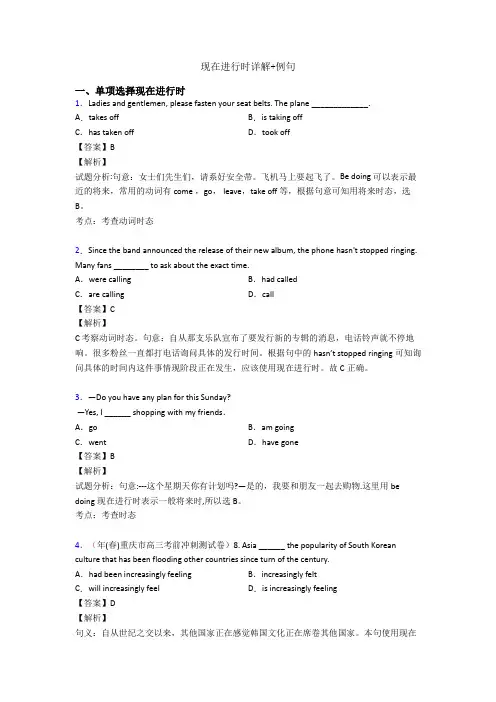
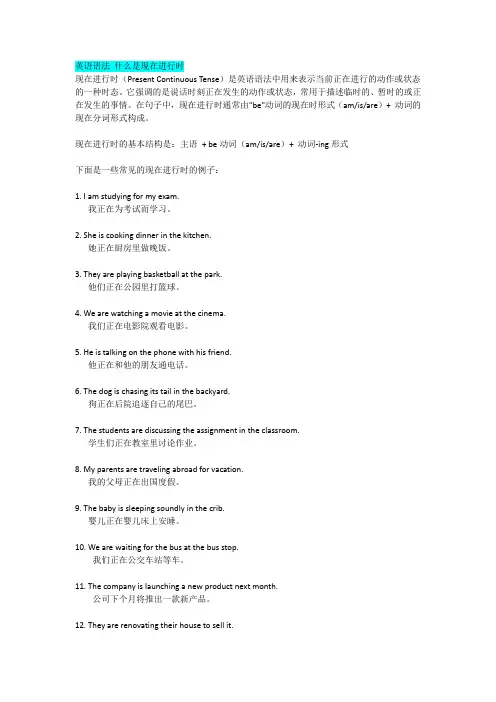
英语语法什么是现在进行时现在进行时(Present Continuous Tense)是英语语法中用来表示当前正在进行的动作或状态的一种时态。
它强调的是说话时刻正在发生的动作或状态,常用于描述临时的、暂时的或正在发生的事情。
在句子中,现在进行时通常由"be"动词的现在时形式(am/is/are)+ 动词的现在分词形式构成。
现在进行时的基本结构是:主语+ be动词(am/is/are)+ 动词-ing形式下面是一些常见的现在进行时的例子:1. I am studying for my exam.我正在为考试而学习。
2. She is cooking dinner in the kitchen.她正在厨房里做晚饭。
3. They are playing basketball at the park.他们正在公园里打篮球。
4. We are watching a movie at the cinema.我们正在电影院观看电影。
5. He is talking on the phone with his friend.他正在和他的朋友通电话。
6. The dog is chasing its tail in the backyard.狗正在后院追逐自己的尾巴。
7. The students are discussing the assignment in the classroom.学生们正在教室里讨论作业。
8. My parents are traveling abroad for vacation.我的父母正在出国度假。
9. The baby is sleeping soundly in the crib.婴儿正在婴儿床上安睡。
10. We are waiting for the bus at the bus stop.我们正在公交车站等车。
11. The company is launching a new product next month.公司下个月将推出一款新产品。
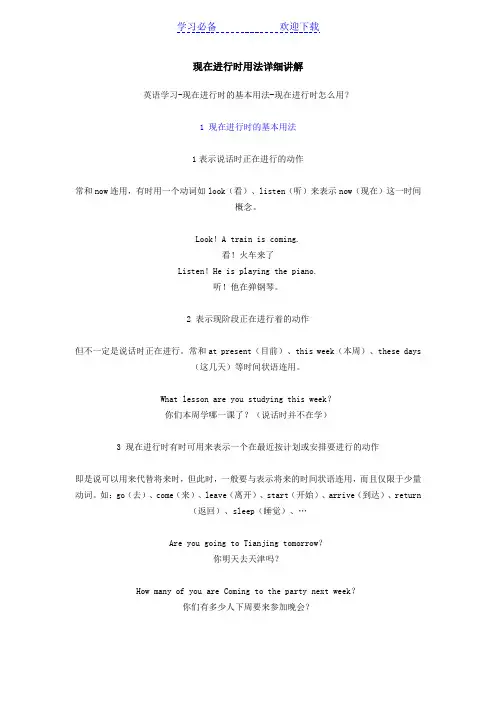
现在进行时用法详细讲解英语学习-现在进行时的基本用法-现在进行时怎么用?1 现在进行时的基本用法1表示说话时正在进行的动作常和now连用,有时用一个动词如look(看)、listen(听)来表示now(现在)这一时间概念。
Look!A train is coming.看!火车来了Listen!He is playing the piano.听!他在弹钢琴。
2 表示现阶段正在进行着的动作但不一定是说话时正在进行。
常和at present(目前)、this week(本周)、these days(这几天)等时间状语连用。
What lesson are you studying this week?你们本周学哪一课了?(说话时并不在学)3 现在进行时有时可用来表示一个在最近按计划或安排要进行的动作即是说可以用来代替将来时,但此时,一般要与表示将来的时间状语连用,而且仅限于少量动词。
如:go(去)、come(来)、leave(离开)、start(开始)、arrive(到达)、return(返回)、sleep(睡觉)、…Are you going to Tianjing tomorrow?你明天去天津吗?How many of you are Coming to the party next week?你们有多少人下周要来参加晚会?4 be going to+动词原形这一句型表示即将发生的事或打算(准备)做的事,我们把它归在将来时里了。
(详见第十章将来时)she isn't going to speak at the meeting.她不打算在会议上发言。
注意如果没有表示将来时间的状语,此类句子就可能指现在或现阶段的动作。
Where are you going next week?下周你计划去哪儿?用现在进行时表示将来时,因为有next week(下周)这一时间状语。
Where are you going?你现在去哪儿?因为没有表示将来时的时间状语,所以就按句型来翻译,即现在进行时。
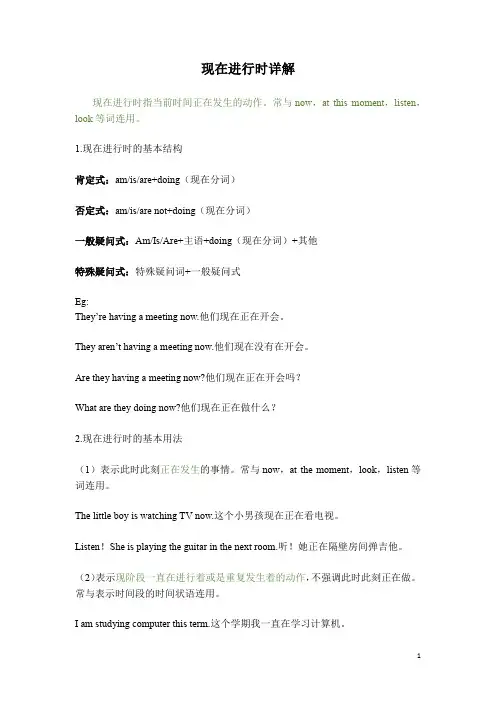
现在进行时详解现在进行时指当前时间正在发生的动作。
常与now,at this moment,listen,look等词连用。
1.现在进行时的基本结构肯定式:am/is/are+doing(现在分词)否定式:am/is/are not+doing(现在分词)一般疑问式:Am/Is/Are+主语+doing(现在分词)+其他特殊疑问式:特殊疑问词+一般疑问式Eg:They’re having a meeting now.他们现在正在开会。
They aren’t having a meeting now.他们现在没有在开会。
Are they having a meeting now?他们现在正在开会吗?What are they doing now?他们现在正在做什么?2.现在进行时的基本用法(1)表示此时此刻正在发生的事情。
常与now,at the moment,look,listen等词连用。
The little boy is watching TV now.这个小男孩现在正在看电视。
Listen!She is playing the guitar in the next room.听!她正在隔壁房间弹吉他。
(2)表示现阶段一直在进行着或是重复发生着的动作,不强调此时此刻正在做。
常与表示时间段的时间状语连用。
I am studying computer this term.这个学期我一直在学习计算机。
(3)表示说话人褒义或贬义的情感色彩,如赞许、批评、喜欢、厌恶等。
此时常与alway、often等频度副词连用。
He is always thinking of others,not of himself.他总是为他人着想,而不为自己。
(表示赞许)One of my roommates is often leaving things about.我的一个室友经常乱扔东西。
(表示不满)(4)表示在近期按计划或安排要发生的动作。

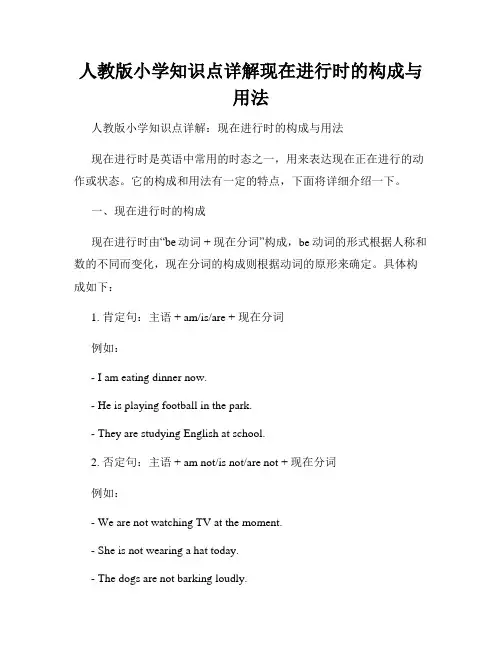
人教版小学知识点详解现在进行时的构成与用法人教版小学知识点详解:现在进行时的构成与用法现在进行时是英语中常用的时态之一,用来表达现在正在进行的动作或状态。
它的构成和用法有一定的特点,下面将详细介绍一下。
一、现在进行时的构成现在进行时由“be动词 + 现在分词”构成,be动词的形式根据人称和数的不同而变化,现在分词的构成则根据动词的原形来确定。
具体构成如下:1. 肯定句:主语 + am/is/are + 现在分词例如:- I am eating dinner now.- He is playing football in the park.- They are studying English at school.2. 否定句:主语 + am not/is not/are not + 现在分词例如:- We are not watching TV at the moment.- She is not wearing a hat today.- The dogs are not barking loudly.3. 一般疑问句:Be动词 + 主语 + 现在分词?例如:- Are you listening to music?- Is he sleeping right now?- Are they playing chess?4. 特殊疑问句:疑问词 + Be动词 + 主语 + 现在分词?例如:- What are you doing?- Where is she going?- Why are they laughing?二、现在进行时的用法现在进行时主要用来表达以下几种情况:1. 表示现在正在进行的动作或活动。
例如:- I am reading a book now.- She is writing a letter to her friend.- They are playing basketball in the gym.2. 表示现阶段正在发生的动作或情况。
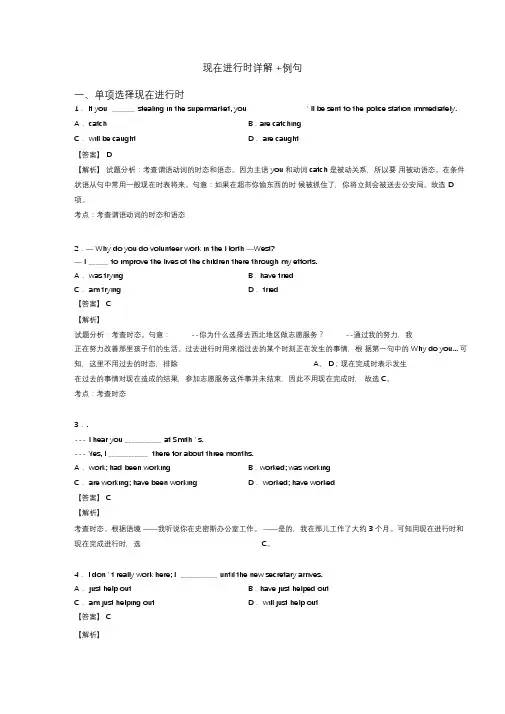
现在进行时详解 +例句一、单项选择现在进行时1.If you _______ stealing in the supermarket, you ' ll be sent to the police station immediately. A.catch B.are catchingC.will be caught D.are caught【答案】D【解析】试题分析:考查谓语动词的时态和语态。
因为主语you 和动词catch 是被动关系,所以要用被动语态。
在条件状语从句中常用一般现在时表将来。
句意:如果在超市你偷东西的时候被抓住了,你将立刻会被送去公安局。
故选D 项。
考点:考查谓语动词的时态和语态2.—Why do you do volunteer work in the North —West?—I ______ to improve the lives of the children there through my efforts.A.was trying B.have triedC.am trying D.tried【答案】C【解析】试题分析:考查时态。
句意:--你为什么选择去西北地区做志愿服务?--通过我的努力,我正在努力改善那里孩子们的生活。
过去进行时用来指过去的某个时刻正在发生的事情,根据第一句中的Why do you... 可知,这里不用过去的时态,排除A、D;现在完成时表示发生在过去的事情对现在造成的结果,参加志愿服务这件事并未结束,因此不用现在完成时,故选C。
考点:考查时态3..--- I hear you ___________ at Smith ' s.--- Yes, I ____________ there for about three months.A.work; had been working B.worked; was workingC.are working; have been working D.worked; have worked【答案】C【解析】考查时态。
现在进行时时态详细讲解_(1)现在进行时表示说话时刻正在进行的动作或时间。
I am not wearing a coat as .it isn t cold. 天气不冷,我没穿外衣。
(2)现在进行时可用来表示不会长期发生的动作或情况,或被认为在短期内正在进行的动作或存在的情况。
--What s your daughter doing these days? 你女儿这些天在干什么?She s studying English at Shandong University. 她在山东大学学英语。
(3)现在进行时可以表示暂时发生的事情。
The river is flowing very fast after last night s rain. 昨夜下过雨之后,河水流速很快。
(4)现在进行时可以表示当前的动向。
People are becoming less tolerant of smoking these days. 如今人们对于吸烟较为难以容忍了。
(5)现在进行时可以表示为将来安排好的活动或时间。
表示趋向行为的动词(come,go, Start, begin, leave等词)常用进行时的形式表示将来时。
The Smiths are moving to Beijing next year. 史密斯一家明年将搬到北京。
(6)现在进行时可以表示重复性动作。
副词always,constantly, forever, repeatedly, all the time 等可以和进行时连用,表示不断重复的作。
此外,还有赞叹、赞许、表扬、抱怨、厌恶等感情色彩。
She is constantly changing her mind. 她经常改变主意。
初中英语语法及现在进行时详解初中英语现在进行时(Present Continuous Tense)用于表示正在进行的动作或状态。
下面是初中英语现在进行时的详细讲解:一、构成:现在进行时的肯定句结构为:主语 + am/is/are + 现在分词(-ing形式)现在进行时的否定句结构为:主语 + am not/isn't/aren't + 现在分词 (-ing形式)现在进行时的疑问句结构为:Am/Is/Are + 主语 + 现在分词(-ing形式)?二、用法:1. 表示当前正在进行的动作:①I am studying English now.(我现在正在学习英语。
)②They are playing basketball in the park.(他们正在公园里打篮球。
)2. 表示暂时的、现阶段正在进行的活动:①She is working as a teacher at the moment.(她目前正在当老师。
)②We are learning about animals in science class.(我们在科学课上学习有关动物的知识。
)3. 表示计划安排好的未来动作:①We are going to the movies tonight.(今晚我们要去看电影。
)②He is meeting his friends for lunch tomorrow.(他明天要和朋友们吃午饭。
)三、注意事项:1. 在现在进行时中,be动词的形式需要根据主语的人称和数来确定,如I am, he is, they are等。
2. 现在进行时的否定句可以在be动词后面加not(缩写为n't),如is not/isn't, are not/aren't。
3. 现在进行时的疑问句需要将be动词放在句首。
4. 在现在进行时中,动词要加上-ing形式的后缀,如playing, studying等。
现在进行时的构成与用法详解现在进行时是英语中的一种时态,用以表示动作发生在现在的时间。
本文将详细介绍现在进行时的构成和用法。
一、构成现在进行时的构成为:助动词be + 现在分词。
其中,助动词be根据主语的不同形式进行变化,现在分词则根据动词的原形加-ing形式构成。
1. 肯定句:主语 + am/is/are + 现在分词例句:- I am studying for my exam.- He is playing football with his friends.- They are watching a movie at the cinema.2. 否定句:主语 + am/is/are + not + 现在分词例句:- She is not working today.- We are not going to the party.- The children are not playing outside.3. 疑问句:Am/Is/Are + 主语 + 现在分词?例句:- Are you listening to music?- Is she cooking dinner?- Are they coming to the concert?二、用法1. 表示当前正在进行的动作现在进行时常用于描述当前正在进行的动作,强调动作正在进行中,通常与时间状语连用。
例句:- I am studying English at the moment.- He is writing an email right now.- They are having a meeting this afternoon.2. 表示计划或安排的未来动作现在进行时还可用于表示将来某个时间已经安排或计划好的动作。
例句:- I am meeting my friends for lunch tomorrow.- She is leaving for the airport at 9 a.m.- They are going on a trip next week.3. 表示不断重复的动作或习惯现在进行时有时也可用于表示频繁发生的动作或习惯。
【答案】D3. The water supply has been cut off temporarily because the workers the main pipe A . rep air C. have rep aired【答案】D 【解析】试题分析:考查动词的时态。
句意:因为工人正在修理主管道,所以水供应暂时被切断。
根据语境表示,修理管道这件事正在进行,所以选 D 项。
考点:考查动词的时态【解析】 试题分析:句意:在我邻居住院的这一周我一直在替她喂猫。
根据句意可知此处表示在某段 时间内一直在做的,be doing 可以表示某个时间正在发生的,也可以指某段时间以来一直 在做的事情,选Co 考点:考查动词时态现在进行时详解+例句一、单项选择现在进行时 1. --The concert won ‘ t start till seven. Why so early? --You know I don' t want to be at the traffic there. It 's terrible during the rushhour.A . are you leaving C. were you leaving 【答案】AB . do you leave D . had you left 【解析】试题分析:考查时态。
句意: --演唱会七点才开始,为什么要走这么早? 上,高峰期的交通状况很糟糕。
根据句意可知是现在的情况,排除 -我不想堵在路C 、D ; go, come,leave,move 等表示位置移动的词,常用进行时表示将来,故选 考点:考查时态 A 。
2. ----Ready to quit guessing , Sandy? ----No, no, I hold on! I think I A come to the an swer. B . have comeC. cameD . am coming【解析】 试题分析:句意: ---准备好不猜了, Sandy ?---不,不,我坚持!我想我马上就知道答案般现在时;B. have come 现在完成时;C. came 一般过去时;D. am comi ng进行时表将来。
现在进行时详解1.基本用法:a. 表示现在( 指说话人说话时) 正在发生的事情。
We are waiting for you.They’re traveling in India.It’s snowing hard. 天正下着大雪。
b. 习惯进行:表示现阶段发生的事,说话时动作未必正在进行。
Mr. Green is writing another novel.(说话时并未在写,只处于写作的状态。
)She is learning piano under Mr. Smith.c. 表示渐变的动词有:get, grow, become, turn, run, go, begin等。
The leaves are turning red.It's getting warmer and warmer.d. 与always, constantly, forever 等词连用,表示反复发生的动作或持续存在的状态,往往带有说话人的主观色彩。
You are always changing your mind.2. 现在进行时和动词的关系1)表示状态和感官的动词,一般不能用于进行时态,特别是know, love, like, belong, detest, hate这类词。
不过这类词中的一些词有其他意思,有时能用于进行时,试比较下面的句子:She looks tired. 她显得很疲惫。
(表示状态或感觉)She is looking a bird. 她在看鸟。
(表示动作,可用于进行时)The food smells nice. 这菜闻着很香。
(表示状态或感觉)He is smelling the flowers. 他在闻花。
(表示动作,可用于进行时)The juice tastes good. 果汁味很好。
(表示状态或感觉)I’m tasting the wine. 我在品尝酒。
(表示动作,可用于进行时)It sounds a good idea. 这听起来是个好主意。
(表示状态或感觉)Why are you sounding the horn? 你为什么按喇叭?(表示动作,可用于进行时)I think you are right. 我认为你是对的。
(表示状态或感觉)What are you thinking of? 你在想什么?(表示动作,可用于进行时)Do you see that tree? 你看到那棵树了吗?(表示状态或感觉)I’m seeing Ted off. 我正在为特德送行。
(表示动作,可用于进行时)It holds two gallons. 它能装两加仑。
(表示状态或感觉)What are you holding in your hand? 你手上拿的是什么?(表示动作,可用于进行时)She has two sisters. 她有两个姐妹。
(表示状态或感觉)She is having lunch. 她在吃午饭。
(表示动作,可用于进行时)2)有些表示动作的动词有时转而表示状态,这时就不宜用于进行时态,如:表示动作表示状态He’s standing on a chair. 他站在椅子上。
My house stands by the river. 我家在江边。
They are sitting on the grass. 他们坐在草地上。
The hut sits in the forest. 小屋在森林里。
She is lying on the beach. 她躺在海滩上。
The town lies before us. 小镇就在我们前方。
He’s fitting the pieces together.他正在装零件。
The coat doesn’t’t fit me. 这上衣不适合我穿。
3)有些表示极短暂动作的动词也不宜用于进行时,如declare, recognize等。
但这类词中有些词有时用语进行时,表示反复做某动作:He’s jumping up and down. 他在来回地跳。
She’s skipping rope. 她在跳绳。
The old man is nodding his head. 老人频频点头。
They’re firing questions at him.他们向他连连发问。
4) be在一般情况下不能用于进行时态,但有时却可以这样用来表示一时的表现:Bob is being silly. 鲍勃这样做是在发傻。
(平时不傻,但这件事上犯傻了)You’re being very clever today. 今天你聪明起来了。
Am I being extravagant? 我这样做是不是太奢侈?The children are being very quiet. I wonder what they’re up to. 孩子们现在特别安静,我纳闷他们想干什么。
You’re being childish. 你这样做太孩子气了。
I’m not being slow. I’m being careful. 我这样并不是动作迟缓,我只是审慎行事。
3.现在进行时表示将来动作1)现在进行时还常可以用来表示将来的动作,特别是在口语中,这时常有一个表示未来时间的状语,多指已计划安排好的事:I’m meeting Peter tonight. He’s taking me to the theatre. 今晚我要和彼得见面,他将带我去看戏。
I’m flying to Hong Kong tomorrow. 我明天飞去香港。
Are you doing anything tomorrow afternoon? ---Yes, I’m playing tennis with Betty. 你明天下午有活动吗?—有,我要和贝蒂打网球。
I’m not going out tonight. I’m staying at home. 今晚我不出去,我要待在家里。
When is Helen coming home? 海伦什么时候回家?They’re getting married next month. 他们下月结婚。
They’re spending the summer at Switzerland. 他们准备在瑞士过夏天。
注意:在以事物作主语时多用一般现在时表示按时间安排的活动:The train leaves at 9:30. 火车9:30开。
The fashion show starts at 7.时装表演七点开始。
The programmer begins at 10.这个节目10点开始。
以人为主语时,多用现在进行时表示计划要做的事:Nancy isn’t coming to the party. 南希不会来参加晚会了。
2)现在进行时也可用在时间和条件从句中表示未来情况:You can do some reading while you are waiting for the train. 你在等火车的时候可以看看书。
You must visit Switzerland when you are traveling in Europe. 你在欧洲旅行时一定要访问瑞士。
If she’s still waiting, tell her to go home. 如果她还在等,可以让她回家。
Suppose it’s still raining tomorrow, shall we go? 假定明天还在下雨,我们要去吗?3)be going to结构可以表示:a. 准备或打算做某事:H’s going to buy a new car. 他准备买一辆新车。
She is not going to be there tonight. 她今晚不准备到那里。
Is he going to lecture in English or in Chinese? 他打算用英语还是用汉语讲课?I’m going to think about it. 我要考虑考虑。
He’s going to be a dentist when he grows up. 他长大了打算当牙医。
What are you going to do when you get your degree? 你拿了学位后打算干什么?b. 即将发生的事或要发生的事:There’s going to be a thunderstorm. 雷雨即将来临。
It’s going to be warm tomorrow. 明天天气会很暖和。
My cousin is going to have a baby. 我表姐要生孩子了。
Amy is going to leave soon, isn’t she? 艾米不久就要走了,是吗?I’m going to be sick. 我要病倒了。
We’re all going to die some day. 总有一天我们都会死的。
在这种结构后也可跟go, come 这类词:Where are you going to go during the holiday? 假期你准备去哪里?They’re going to come with me. 他们准备和我一道去。
4. 现在进行时表示经常性动作现在进行时还可以用来表示经常性的动作,常和always, constantly, forever这类副词连用,表示厌烦、赞美等情绪:He is always losing his keys. 他老是丢钥匙。
(不以为然)I’m always making that mistake. 我老犯那个错。
(不耐烦)She’s always working. 她总是在工作。
(赞赏)You’re always thinking of others. 你总是在为别人着想。
(赞美)She’s constantly changing her mind. 她总是改变主意。
(不满)The baby is constantly screaming. 宝宝总是尖叫。
(不耐烦)He’s forever finding fault with what I do. 他总是找我的茬。
(厌烦)She’s perpetually nagging. 她总爱唠叨。
(厌烦)2)这类句子也可以用一般现在时,这时只说明事实,用现在进行时则表示某种情绪,试比较下面句子:用一般现在时(说明事实)用现在进行时(表示某种情绪)How do you feel today? How are you feeling today? (关切)We haul in lots of fish today. We’re hauling in lots of fish today. (欣慰) She does fine work at school. She’s doing fine work at school. (赞美) He often complains of his job. He’s always complains of his job. (厌烦) 3)有些静态动词有时也可以用于现在进行时:I’m hoping you’ll all come. 我希望你们都来。